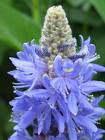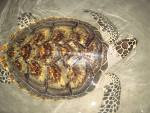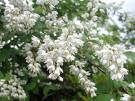::::::::::::::::::::::::::::::::::::::::::::::::::::::::::::::::::::::::::::::::::::::::::::::::::::
White dew (shiratsuyu, hakuro)
***** Location: Japan
***** Season: Autumn
***** Category: Heaven
*****************************
Explanation
white dew, shiratsuyu, shira-tsuyu, shira tsuyu, hakuro 白露

Read all about
Dew, dewdrops (tsuyu)
*****************************
Worldwide use
*****************************
Things found on the way
*****************************
HAIKU
. Matsuo Basho 松尾芭蕉 - Archives of the WKD .
Memorial stone of a haiku by Matsuo Basho.
白露もこぼさぬ萩のうねりかな
shiratsuyu mo kobosanu hagi no uneri kana

the white dew
is not even scattered (while) the bush clover
is swaying . . .
Literal translation by Gabi Greve
Temple Myo-O In in Gunma and Fudo Myo-O
(This haiku has the cut marker KANA at the end of line 2.)
A bit more poetic, but neglecting the KANA
not even spilling
the white dew -
swaying bush clover

. . . Compiled by Larry Bole
This haiku of Basho's is from 1693, the year before he died. Bush clover ('hagi') is traditionally associated with dew, among other things. Bush clover has also been used to represent women, as Basho did in his "bush clover and moon" haiku from "The Narrow Road."
Though bush-clover
always stirs,
not one dewdrop falls.
trans. Lucien Stryk
without dropping
its bright white dew,
a bush clover sways
trans. Barnhill
Bushclover undulates
without scattering
the white dew
trans. Stephen Addiss
Bush clover in blossom waves
Without spilling
A drop of dew.
translator not found--see:
http://thegreenleaf.co.uk/HP/basho/00Bashohaiku.htm
The flowers of the bush-clover
Do not let fall, for all their swaying,
Their drops of bright dew.
trans. Blyth
Blyth comments:
The lespedeza, or bush-clover, is a graceful bush-like plant whose stems rise from the ground and bend over all together like the spray of a fountain. When the wind blows, the bushes move in waves, but the white and red blossoms do not drop the dew or rain that they hold.
This verse is to some extent a picture, but only a poet could paint it, and only a poet could see it.
[end of comment]
Bush-clover does not spill
one small white dewdrop--though its waves
are never still.
trans. Henderson
Henderson comments:
Other versions have 'wo' for 'mo', and 'hito-tsuyu' (one dewdrop) for 'shiro-tsuyu'. This translation is rather free, in the belief that 'uneri' refers more to waves like the waves of a wheat field than to the actual curve of the branches..., and that "dewdrop" has its usual suggestion of short human life. There are many explanations of this poem, ranging from the highly religious to the erotic.
[end of comment]

Where I have shown an ellipses in Henderson's comment, he is making a comparative reference to a haiku by Issa (regarding bush-clover and waves):
hagi mohaya ironaru nami ya yu harai
Bush-clover there,
now all in waves of color:
evening prayer!
Issa, trans. Henderson
Henderson says that this haiku is a "picture of the Hagi-Tamagawa at sunset."
He goes on to say:
"There were six Tamagawa (Jewel Rivers 玉川) all celebrated in literature and art."

Hagi Tamagawa 萩の玉川
Mu Tamagawa 六玉川 Six Tama Rivers
Six Tamagawa by Hiroshige
Toi Tama River
Noji Tama River 野路の玉川
. Ide Tama River 井手の玉川 Ide no Tamagawa - Kyoto .
Chofu Tama River 調布の玉川
Koya Tama River 高野の玉川
Noda Tama River 野田の玉川
other varieties include
たづくりの玉川 Tazukuri no Tamagawa
橋衣の玉川
. Cloth-fulling Jewel River 壔衣の玉川 .
Tamagawa is also spelled: 多摩川
Mu Tamagawa Go Nenkan - Almanac of Six Jewel Rivers
Six poems on Jewel rivers by most respectable poets.
presented by Wolfgang Klose
source : mu_tamagawa.html

Utagawa Hiroshige
- Reference -
:::::::::::::::::::::::::::::::::::::::::::::::::::::::::::::::::::::::::::::::::::::::::::::::::::::::::::::::::
- - - - - Yosa Buson - - - - -

白露や茨の刺にひとつづつ
白露や茨の刺に一つずつ
shiratsuyu ya ibara no toge ni hitotsu-zutsu
White dew on the bramble;
One drop
On each thorn.
Tr. Blyth
White dew--
one drop
on each thorn.
Tr. Hass
Morning dewdrops--
Upon the briar thorns
One on each.
Tr. Nelson/Saito
White drops of dew
on spines of the thornbush,
one for each!
Tr. Sawa/ Shiffert
quote
White dew –
A drop on each thorn
Of the bramble.
It is very simple. There are only two elements — the dew and the bramble, but notice how they are presented. A single drop hangs from each of the thorns on a branch of the bramble. We see its cold transparence in the light of morning — the yin softness of water, the yang hardness of the bramble thorns. One element is very transitory — soon gone when the sun rises higher — the other more permanent, but still as transient on its own time scale.
It is a good idea to have something that moves or changes in hokku. Generally we see things that do so obviously — a branch moving in the wind, a fish swimming through the water. But in this hokku the movement is only implied, and very subtle — the temporary nature of the dew, the knowledge not only that at any moment one of those drops could fall from a thorn, but that the dew itself will likely only last the morning.
Buson sometimes tended to spoil his hokku by making them too artificial, too contrived from literary sources, or too obviously intended to impress. He was both a painter and a writer, and his writing is often influenced by his painting. But in this hokku it is the simplicity and faithfulness to Nature that saves him.
source : David Coomler
. WKD : Wild roses (茨 ibara, nobara) .
白露やさつ男の胸毛ぬるるほど
shiratsuyu ya satsu-o no munage nururu hodo
With a frost of dewdrops
The hairs upon the hunter's chest
Are dripping wet.
Tr. McAuley
White dewdrops!
Enough to dampen the hair
on the hunter's chest.
Tr. Sawa/ Shiffert
satsuo 猟男 - 猟夫 a hunter
白露の身や葛の葉の裏借家 - shiratsuyu no mi ya
白露の篠原に出る檜原かな - shiratsuyu no shinohara
. Yosa Buson 与謝蕪村 in Edo .
:::::::::::::::::::::::::::::::::::::::::::::::::::::::::::::::::::::::::::::::::::::::::::::::::::::::::::::::::
- - - - - Kobayashi Issa - - - - -
白露に片袖寒き朝日哉
shira tsuyu ni kata sode samuki asahi kana
one sleeve cold
with clear dew
in morning sun
Tr. Chris Drake
This autumn hokku was written between 1797 and 1799, when Issa was traveling around in western Japan, returning to Edo by 1799. The nights are getting longer and colder, and dew lies thick early in the morning. The point of view in the hokku suggests it is probably based on an experience Issa had. If so, then when Issa set out, there was dew on both his sleeves, but as he walks along the morning sun shines on him at an angle, warming and drying only one sleeve, leaving him with the uncanny feeling of living in the past and the present at the same time. His cold, wet sleeve in shadow still somehow "contains" time from the previous night and from when he set out, while the other sleeve, in sunlight, is comfortable and warm and forward-looking, foretelling the future of the sleeve in shadow.
Dewdrops are a widely used image in Japanese poetry and religion for time passing and the ephemerality of all things, but it is difficult to portray the exact moment when a dewdrop vanishes in the light and heat of the sun. This hokku, however, manages to obliquely suggest that moment by using a robe and the wearer of the robe (and by extension, the human body) as a physical representation of the moment of the dew's disappearance, thus spatializing time. The distance between one sleeve and the other (the width of the wearer's body or body-mind) is also the amount of time Issa has been walking in the sun, as if time were something palpable. This image implicitly affirms the Buddhist notion of the human body as a form of clear, translucent dew in motion -- a form that is easily disguised by the dry, relatively unchanging shapes of the daylight world, including the shapes of dry robes. The concept is old, but a physical experience of the concept by means of, for example, a hokku is hard to attain.
Chris Drake
. Kobayashi Issa 小林一茶 in Edo .
:::::::::::::::::::::::::::::::::::::::::::::::::::::::::::::::::::::::::::::::::::::::::::::::::::
. . Compiled by Larry Bole
白露に阿吽の旭さしにけり
shiratsuyu ni aun no asahi sashinikeri
On the white dewdrops
Shines the alpha and omega
Of morning sunlight.
Boosha, trans. Donald Keene
shiratsuyu ni shigo ken no komura kana
In the white dew,
Four or five houses,
A hamlet.
Shiki, trans. Blyth
shiratsuyu ni joudomairi no keiko kana
From the white dew-drops,
Learn the way
To the Pure Land.
Issa, trans. Blyth
shiratsuyu ni sabishiki aji o wasururu na
Never forget
The lonely taste
Of the white dew.
Basho, trans. Blyth
白露や死んでゆく日も帯しめて
shiratsuyu ya shinde yuku hi mo obi shimete
the white dew . . .
on the day when I die too
tying my obi
Mitsuhashi Takajo
trans. UVa Library Etext Center: Japanese TextInitiative
And speaking of shiratsuyu, during WWII,
the Japanese Navy named various types of destroyers after various types of weather, and other elements of nature, such as varous moon names, various wind names, clouds, seasons. There was a class of destroyers called Shiratsuyu (White Dew, Shimmering Dew), named after the lead ship of the class.
I suspect there were a lot of names of Japanese destroyers that could be found as words used in haiku and other Japanese poetry.

白露型
:::::::::::::::::::::::::::::::::::::::::::::::::::::::::::::::::::::::::::::::::::::::::::::::::::
In a gust of wind the white dew
On the autumn grass
Scatters like a broken necklace.
—Bunya No Asayasu
.. Tr. Sam Hamill, Love Poems from the Japanese
*****************************
Related words
***** Dew, dewdrops (tsuyu)
***** Bush clover (hagi)
***** ..... WHITE in Haiku (shiroi, haku)
:::::::::::::::::::::::::::::::::::::::::::::::::::::::::::::::::::::::::::::::::::::::::::::::::::::
[ . BACK to DARUMA MUSEUM TOP . ]
[ . BACK to WORLDKIGO . TOP . ]
:::::::::::::::::::::::::::::::::::::::::::::::::::::::::::::::::::::::::::::::::::::::::::::::::::::




































